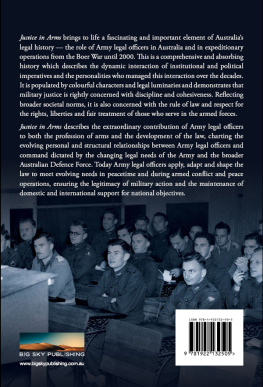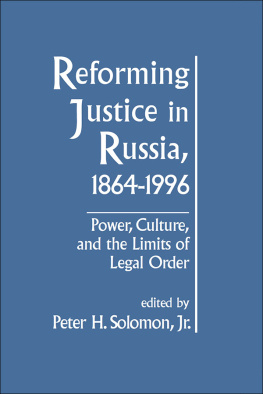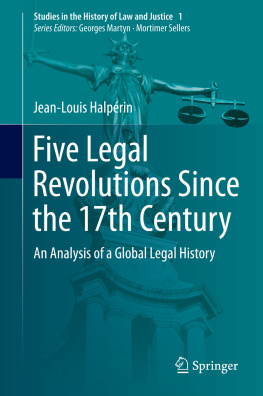JUSTICE
IN ARMS
MILITARY LAWYERS IN THE AUSTRALIAN
ARMYS FIRST HUNDRED YEARS

AUSTRALIAN ARMY LEGAL CORPS
EDITED BY BRUCE OSWALD AND JIM WADDELL
Copyright Commonwealth of Australia
First published 2014
Copyright remains the property of the Commonwealth and apart from any fair dealing for the purposes of private study, research, criticism or review, as permitted under the Copyright Act, no part may be reproduced by any process without written permission.
All inquiries should be made to the publishers.
Big Sky Publishing Pty Ltd
PO Box 303, Newport, NSW 2106, Australia
Phone: 1300 364 611
Fax: (61 2) 9918 2396
Web: www.bigskypublishing.com.au
Cover design and typesetting: Think Productions
Printed in China by Asia Pacific Offset Ltd.
See National Library of Australia for Cataloguing-in-Publication entry
ISBN: 978-1-922132-50-5
JUSTICE
IN ARMS
MILITARY LAWYERS IN THE AUSTRALIAN
ARMYS FIRST HUNDRED YEARS

AUSTRALIAN ARMY LEGAL CORPS
EDITED BY BRUCE OSWALD AND JIM WADDELL
THE AUSTRALIAN ARMY HISTORY COLLECTION

Winning with Intelligence
Judy Thomas
Duntroon
Darren Moore
The Warrior Poets
Robert Morrison
The History of the Royal Australian Corps of
Transport 19732000
Albert Palazzo
Defenders of Australia
Albert Palazzo
The Fight Leaders
D. Butler, A. Argent and J. Shelton
Operation Orders
Pat Beale
Little by Little
Michael Tyquin
Red Coats to Cams
Ian Kuring
Bowler of Gallipoli
Frank Glen
Vets at War
Ian M. Parsonson
Only One River to Cross
A.M. Harris
The Fragile Forts
Peter Oppenheim
Hassett: Australian Leader
John Essex-Clark
Persian Expedition
Alan Stewart
The Chiefs of the Australian Army
James Wood
Never Late
Gordon Dickens
To Villers-Bretonneux
Peter Edgar
Madness and the Military
Michael Tyquin
The Battle of Anzac Ridge 25 April 1915
Peter D. Williams
Doves Over the Pacific
Reuben R.E. Bowd
The Lionheart
David Coombes
Battlefield Korea
Maurie Pears
Chemical Warfare in Australia
Geoff Plunkett
A Most Unusual Regiment
M.J. Ryan
Between Victor and Vanquished
Arthur Page
Country Victorias Own
Neil Leckie
Surgeon and General
Ian Howie-Willis
Willingly into the Fray
Catherine McCullagh
Beyond Adversity
William Park
Crumps and Camouflets
Damien Finlayson
More than Bombs and Bandages
Kirsty Harris
The Last Knight
Robert Lowry
Forgotten Men
Michael Tyquin
Battle Scarred
Craig Deayton
Crossing the Wire
David Coombes
Do Unto Others
Alan H Smith
Fallen Sentinel
Peter Beale
Sir William Glasgow
Peter Edger
Training The Bodes
Terry Smith
Bully Beef and Balderdash
Graham Wilson
Fire Support Bases Vietnam
Bruce Picken
Toowoomba to Torokina
Bob Doneley
A Medical Emergency
Ian Howie-Willis
Dust, Donkeys and Delusions
Graham Wilson
The Backroom Boys
Graeme Sligo
Captains of the Soul
Michael Gladwin
CONTENTS
Chapters:
Colonel Jim Waddell
Colonel Jim Waddell
3 We are more concerned with the good soldier than the bad one in war:
the Australian Army Legal Department 19391942
Lieutenant Colonel Lachlan Mead
4 Not exactly heroic but still moderately useful: Army legal work
during the Second World War 19391945
Lieutenant Colonel Lachlan Mead
Lieutenant Colonel Lachlan Mead
Major Peter Cumines and Captain Andrew Mitchell
Lieutenant Colonel George Karsai
Colonel Ken Northwood
Colonel David Wilkins
Brigadier Andrew Dunn
Colonel Bruce Oswald
Appendices:
2 Judge Advocates General and Deputy Judge Advocates General,
Australian Military Forces
3 Judge Advocates General and Deputy Judge Advocates General,
Australian Defence Force
by the Hon R.S. French, AC, Chief Justice of Australia
This book brings to life an important part of Australias legal history the role of Army legal officers in the Australian Army from Federation to the beginning of the twenty-first century. It is no mere sequence of minor biographies. It is a history which brings out the dynamic interaction of institutional and political imperatives in tension and the personalities who managed those tensions over the decades. It is populated by colourful characters and legal luminaries. The book contains a total of 11 chapters, written by nine different authors. It is comprehensive, detailed and absorbing. As it demonstrates, military justice is rightly concerned with discipline and cohesiveness. Reflecting broader societal norms, it is also concerned with the rule of law and respect for the rights, liberties and fair treatment of the men and women of the armed services. Those concerns and the tensions which they can generate emerge from the history. So too, does the increasing complexity of the legal environment in which the Australian Army, in common with the other defence services, works particularly in joint and peacekeeping operations with operational constraints.
The first two chapters of the book, written by Colonel Jim Waddell, cover the period from Federation to the end of the First World War and thereafter the establishment of the Australian Army Legal Department (AALD) and its operation up to the beginning of the Second World War. The constitutional birth of the Australian Army began with the transfer of control of administration of defence from the states to the Commonwealth of Australia following Federation on 1 March 1901. The Defence Act 1903 (Cth) set up a legal framework for military discipline which was to last for 80 years. It applied the Army Act 1881 (UK) to Australian soldiers on active service except to the extent of its inconsistency with the Defence Act. Soldiers not on active service were governed by a modified Disciplinary Code and Regulations.
The first lawyers involved in the Australian Army were officers with legal qualifications who served in the Boer War. Among them was Major J.T. Thomas, a Tenterfield solicitor. He defended Morant, Handcock and Witton at their courts martial in 1902. Morant and Handcock were executed for shooting Boer prisoners and a German missionary. Colonel Waddell cites a view propounded by Dr John Bennett that the failure of the defence case can be attributed in large measure to Thomas ineptitude and inexperience. A more celebrated lawyer of the time was Major Robert de Courcy Talbot, who became the first Deputy Judge Advocate General. He provided a number of important advices to the Commonwealth Government including an advice about the legal status of the contingents which had been dispatched to South Africa in 1902 by the Commonwealth in response to a request from the British Government. His appointment as Australias first Deputy Judge Advocate General was apparently not uncontroversial. It attracted a rather bizarre attack by
Next page








